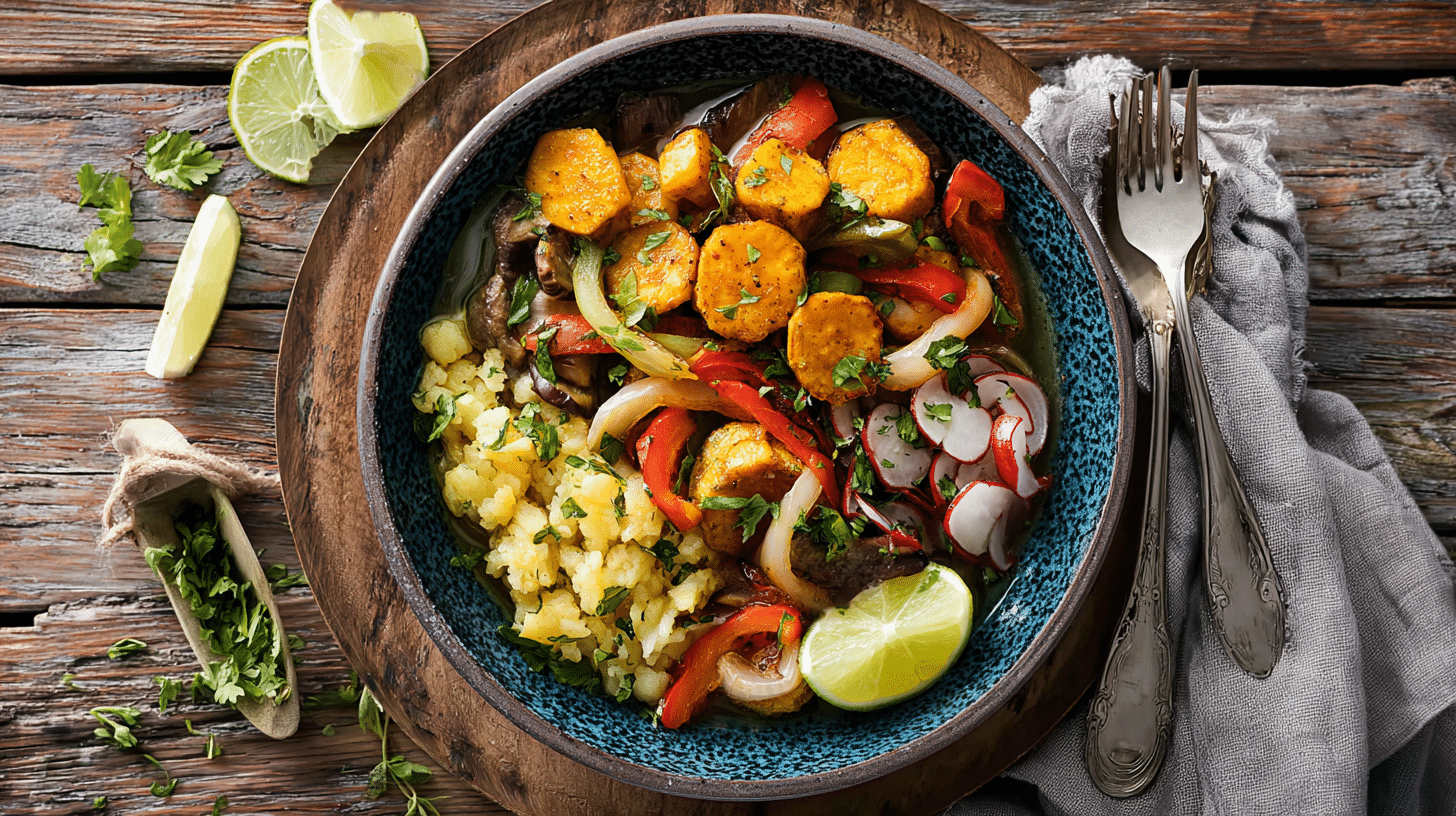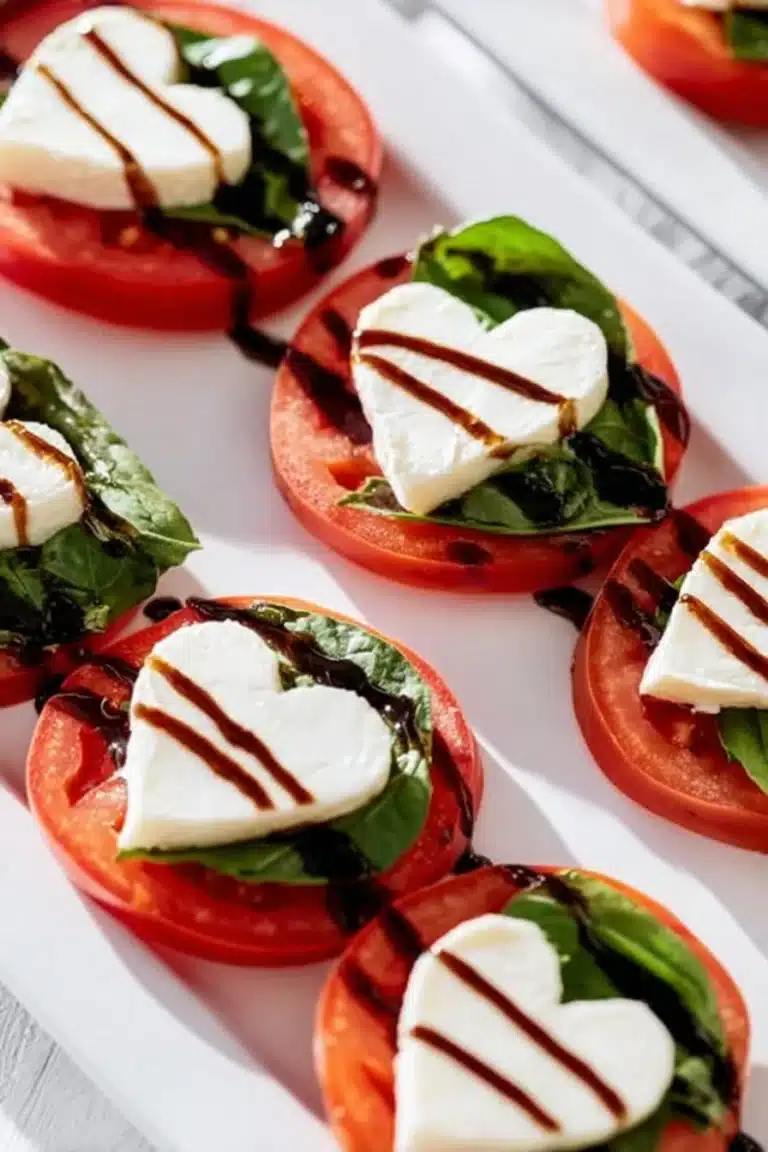Cuban vegetable recipes bring together bold spices, humble ingredients, and soulful traditions. From crispy plantains to garlicky yuca and stewed squash, this collection delivers a delicious taste of island life in every bite. Whether you’re curious about traditional Cuban food or looking to expand your vegetarian lineup, these recipes will guide you through the heart of Cuban vegetable recipes using authentic flavors and approachable steps.
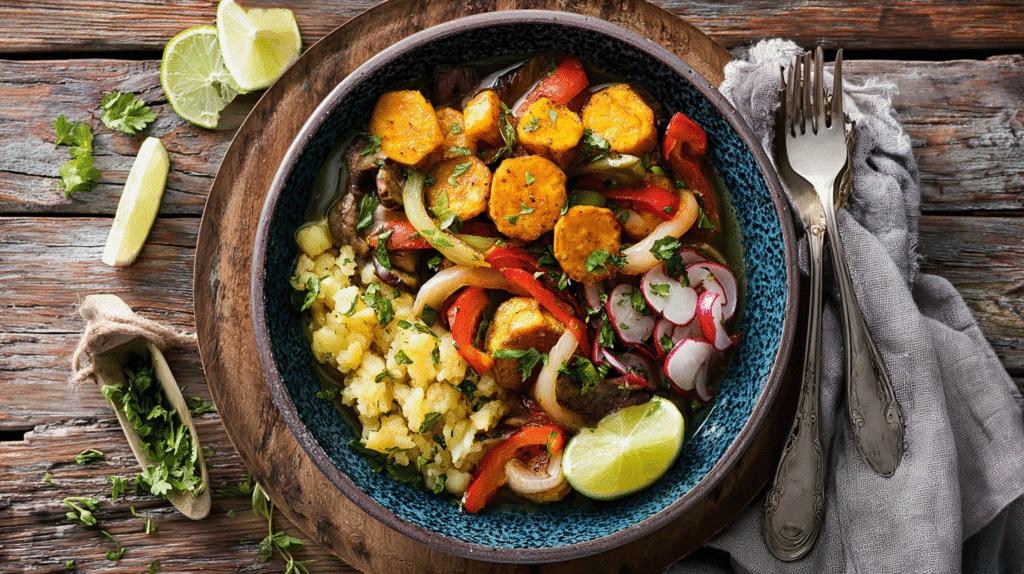
PART 1: The Story & Intro — A Comfort Dish from the Island
From Nostalgia to Nourishment: How Cuban Vegetable Recipes Found My Table
Growing up, the smell of roasted peppers and onions was a constant comfort in my grandmother’s kitchen. But it wasn’t until I started exploring Caribbean food that I understood how powerfully simple ingredients could hold so much culture. At Recent Recipe, we believe food should spark memory, comfort, and curiosity—exactly what these Cuban vegetable recipes do with every simmer and sizzle.
It started with a craving for something both vibrant and grounding. I remembered the first time I had yuca con mojo, the citrusy garlic sauce soaking into the tender root. I was hooked. Then came the sweet plátanos maduros, followed by crispy green plantains pressed into golden tostones. These weren’t just sides—they were family stories, rewritten through flavor.
This post brings together seven authentic, home-style dishes. They’re not “inspired by” Cuban food—they are Cuban food. And if you’re looking for real Cuban vegetable recipes made with real ingredients, you’re in the right place.
You’ll discover how black beans simmer into creamy richness, why calabaza squash stewed with sofrito is a dinner table essential, and how a simple avocado salad can elevate your plate into something worthy of Sunday tradition.
From the street-food charm of fried plantains to the earthy comfort of cassava with mojo, each recipe celebrates Cuba’s agricultural heart and the flavors that define it. These are recipes your table—and your guests—will remember.
Why We Crave the Flavors of Cuban Cuisine
Cuban food is deeply rooted in resilience. Throughout history, Cuban cooks have taken what they had—root vegetables, legumes, tropical fruits—and transformed them into something deeply flavorful. That’s the magic of Cuban vegetable recipes: turning modest ingredients into unforgettable meals. Whether it’s the tang of citrus or the perfume of cumin, every bite carries the legacy of kitchens built on community and creativity.
Each dish in this guide represents more than a recipe. It’s a story passed down, simmered, shared, and now—ready for your plate.
What You’ll Find in These 7 Recipes
Get ready to explore the flavorful world of Cuban vegetable side dish recipes and mains like:
- Cuban roasted peppers and onions with a smoky kick
- Crispy green plantains (tostones) and their sweet ripe counterpart, plátanos maduros
- Yuca con mojo dripping in citrus and garlic
- Calabaza a la Cubana—sweet squash in tomato sofrito
- A hearty Cuban black beans bowl
- Ensalada de aguacate—Cuba’s refreshing take on avocado salad
And if you’re wondering what to serve with Cuban black beans, or curious about the “Cuban potato-like vegetable,” don’t worry—those FAQs are coming too. Just keep reading.
Coming up next: the core ingredients that make every one of these dishes unforgettable.
PART 2: Inside Cuban Flavor Traditions
The Building Blocks of Authentic Cuban Vegetable Recipes
To cook Cuban vegetable recipes that taste truly authentic, you first need to understand the pantry. Cuban cuisine relies heavily on a few core spices and staple vegetables, used in clever ways to extract maximum flavor without complex methods. It’s a cuisine shaped by necessity and lifted by culture.
Cumin, oregano, garlic, and onions aren’t just common—they’re foundational. The starting point for nearly every savory Cuban dish is a sofrito, a rich base of sautéed garlic, onions, and bell peppers, often combined with tomato and spices. This fragrant mixture builds flavor layer by layer, and once you’ve mastered it, your kitchen will smell like Cuba.
Print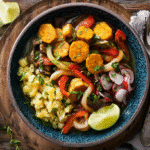
7 Authentic Cuban Vegetable Recipes You Must Try
- Total Time: 55 minutes
- Yield: 4 servings 1x
Description
This Cuban vegetable recipe roundup features 7 easy, flavorful, and authentic dishes like yuca con mojo, calabaza stew, and tostones. Perfect for vegan and gluten-free meals.
Ingredients
2 green plantains
2 ripe plantains
1 lb yuca
2 cups calabaza
2 red/yellow bell peppers
1 red onion
4 garlic cloves
olive oil
lime juice
cumin
oregano
salt
black pepper
1 cup cooked black beans
avocados
Instructions
1. Peel and prep your plantains, yuca, and squash.
2. Roast peppers and onions with oil and spices.
3. Fry green plantains twice for tostones.
4. Boil yuca and top with mojo sauce.
5. Sauté squash with sofrito until tender.
6. Fry ripe plantains until golden.
7. Mix avocado salad with lime, oil, and onion.
8. Serve each dish with Cuban black beans.
Notes
Use butternut squash if calabaza isn’t available.
Green plantains = crispy, ripe = sweet.
Yuca is best fresh but can be found frozen.
Beans and squash freeze well.
Make sofrito in bulk for easier prep.
- Prep Time: 20 minutes
- Cook Time: 35 minutes
- Category: Side Dish
- Method: Roasting, Frying, Boiling
- Cuisine: Cuban
Nutrition
- Serving Size: 1 cup
- Calories: 180
- Sugar: 4g
- Sodium: 210mg
- Fat: 7g
- Saturated Fat: 1g
- Unsaturated Fat: 5g
- Trans Fat: 0g
- Carbohydrates: 30g
- Fiber: 4g
- Protein: 3g
- Cholesterol: 0mg
Keywords: cuban vegetable recipes, yuca con mojo, tostones, calabaza, black beans
Here’s a breakdown of the essential ingredients that show up across the seven Cuban vegetable recipes:
| Core Ingredient | Why It Matters |
|---|---|
| Cumin | Adds earthy depth and warmth, essential in beans and yuca mojo. |
| Oregano | Brings subtle bitterness and fragrance to sofrito and stews. |
| Allspice | Lends a warm, clove-like note found in traditional Cuban spice blends. |
| Garlic | A non-negotiable in every Cuban kitchen, especially in mojo sauce. |
| Plantains (green and ripe) | Green for tostones (crispy), ripe for maduros (sweet). Versatile and beloved. |
| Yuca (Cassava) | Cuba’s answer to potatoes—dense, starchy, and perfect with mojo. |
| Calabaza | A Cuban pumpkin/squash used in stews—slightly sweet and tender when cooked. |
These ingredients also align perfectly with a vegan Cuban food lifestyle and are naturally gluten-free, which is why many of these dishes are featured in popular health-conscious Cuban recipe posts.
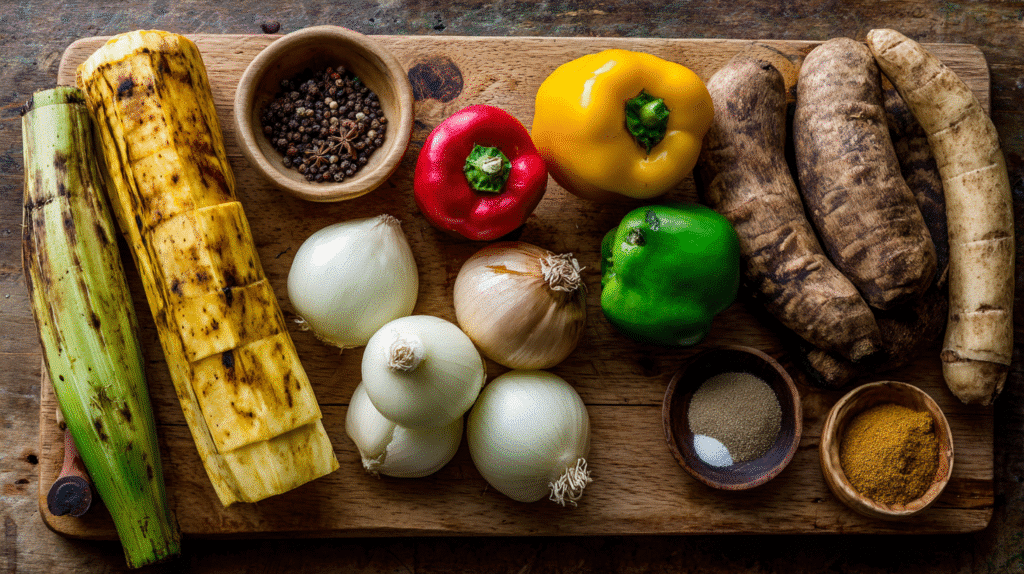
Prepping Cuban Veggies: Easy Steps for Big Flavor
Let’s keep it simple. Preparing vegetables Cuban-style doesn’t require fancy gadgets—just sharp knives, a stovetop, and sometimes a baking sheet. The most important part is timing and balance.
When prepping plantains, know your type:
- Green plantains = tostones. Slice thick, fry, flatten, fry again.
- Ripe plantains = plátanos maduros. Slice diagonally and fry once.
Want to use calabaza but can’t find it? Try butternut squash—it’s a perfect stand-in and just as sweet when slow-cooked with sofrito.
Need yuca? You’ll often find it in frozen sections of Latin markets. Peel carefully, boil until fork-tender, then coat with garlic-lime mojo sauce for unforgettable flavor.
And don’t forget: a good sofrito is the real backbone. Take your time sautéing the onions, peppers, and garlic—this isn’t where you want to rush. The richer your sofrito, the more flavorful your dishes will become.
You’ll find that all these steps and ingredients are beautifully simple. These are easy Cuban recipes, but they never taste basic.
Explore our complete collection of Cuban lunch dishes for even more island-inspired flavors beyond traditional sides.
PART 3: Cuban Vegetable Recipes That Bring the Island to Your Plate
If you’re ready to cook with color, soul, and tradition, these Cuban vegetable recipes offer everything from crunchy bites to velvety comfort food. These are the dishes Cuban abuelas serve with pride, and now they’re yours to make at home.
1. Cuban Roasted Peppers and Onions
This simple side dish bursts with smoky sweetness. Roasting caramelizes the peppers and deepens their flavor, while onions soften and melt into the mix. Perfect next to Cuban rice or grilled tofu.
Ingredients:
- 1 red bell pepper, sliced
- 1 yellow bell pepper, sliced
- 1 medium onion, sliced
- 2 tablespoons olive oil
- 1/2 teaspoon cumin
- 1/2 teaspoon oregano
- Salt and pepper to taste
Instructions:
- Preheat oven to 400°F.
- Toss vegetables with oil and spices.
- Spread evenly on a baking sheet.
- Roast for 25–30 minutes, flipping halfway.
- Serve warm as a side or filling.
This pairs beautifully with any Cuban dinner plate, especially those featuring beans or rice.
2. Crispy Baked Plantains (Tostones Style)
Tostones are green plantains cooked twice for a crispy, golden finish—and they’re naturally gluten-free. They’re a Cuban street-food classic and one of the most beloved Cuban side dishes.
Ingredients:
- 2 green plantains
- 2 tablespoons vegetable oil
- Salt
Instructions:
- Peel plantains, slice into 1-inch rounds.
- Fry once in oil for 2–3 minutes each side.
- Remove, flatten with a glass or tostonera.
- Return to pan, fry again until crispy.
- Sprinkle with salt and serve hot.
Craving more Latin-style sides? Visit our full lunch recipe archive for quick weekday inspirations.
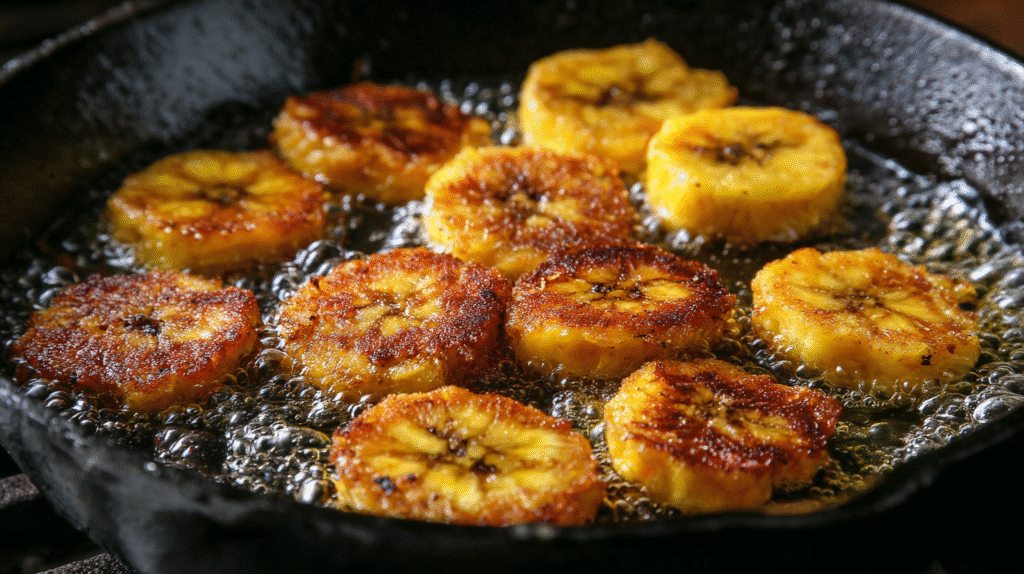
3. Yuca con Mojo
Think of this as the Cuban answer to mashed potatoes—but better. Yuca (cassava) gets boiled until tender, then drenched in mojo: a garlic-citrus sauce that transforms this root veggie into a flavor bomb.
Ingredients:
- 1 lb yuca, peeled and cut into chunks
- 4 garlic cloves, minced
- 1/4 cup olive oil
- 1/4 cup fresh lime juice
- 1/2 teaspoon cumin
- Salt to taste
Instructions:
- Boil yuca for 25–30 minutes until fork-tender.
- In a saucepan, sauté garlic in olive oil until golden.
- Add lime juice and cumin to make mojo sauce.
- Pour over yuca and serve warm.
This dish is also featured in many vegetarian Cuban food menus—it’s bold and satisfying without any meat.
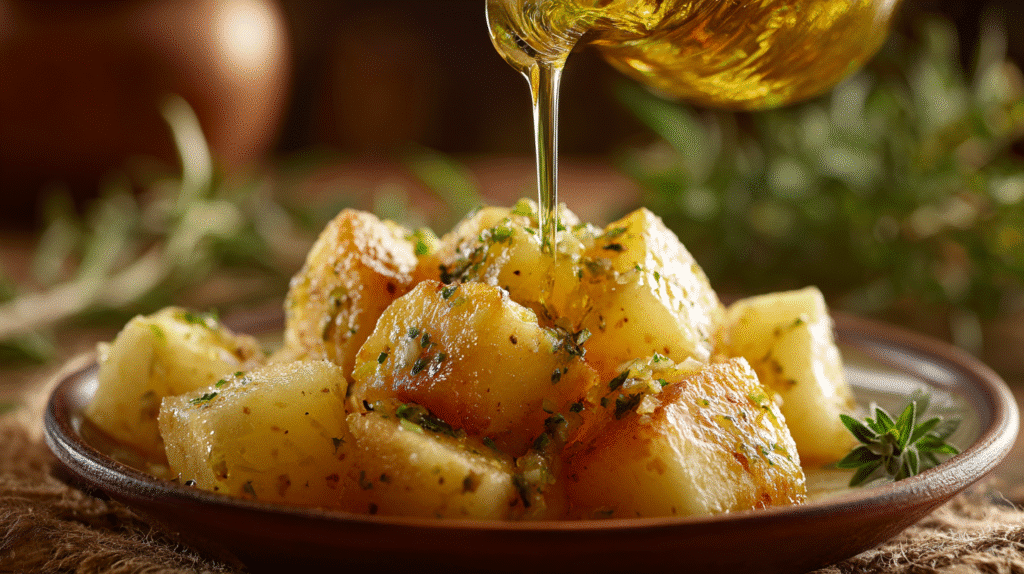
4. Plátanos Maduros Fritos (Sweet Fried Plantains)
A Cuban staple, this dish uses ripe plantains for a caramelized, soft texture that contrasts beautifully with savory mains.
Ingredients:
- 2 ripe plantains (black spots OK)
- 2 tablespoons vegetable oil
- Pinch of salt
Instructions:
- Peel plantains and slice diagonally.
- Heat oil in pan over medium heat.
- Fry plantains 2–3 minutes per side until golden.
- Sprinkle with salt, serve hot.
Serve with black beans for a sweet-savory combo you’ll crave again and again.
5. Calabaza a la Cubana (Cuban-Style Stewed Squash)
One of the most traditional Cuban vegetables, calabaza squash simmers in sofrito until soft and flavorful. A perfect dish for fall or comfort-food nights.
Ingredients:
- 2 cups calabaza squash (or butternut), cubed
- 1/2 onion, diced
- 1/2 bell pepper, diced
- 2 garlic cloves, minced
- 1/4 teaspoon cumin
- 1/4 teaspoon oregano
- 1 cup tomato sauce
- Salt and pepper
Instructions:
- Sauté onion, pepper, and garlic in oil.
- Add tomato sauce, spices, and squash.
- Simmer covered for 20 minutes until tender.
- Stir occasionally, adjust seasoning.
Add it to your vegetable-packed dinner lineup for variety.

6. Cuban Black Beans
Rich, savory, and comforting, Cuban black beans are an authentic Cuban cuisine essential. Whether served with rice or plantains, this dish delivers deep, spiced flavor.
Ingredients:
- 1 cup dried black beans (or 1 can, drained)
- 1/2 onion, chopped
- 2 garlic cloves, minced
- 1/2 bell pepper, chopped
- 1/2 teaspoon cumin
- 1 bay leaf
- 1 tablespoon olive oil
- Salt to taste
Instructions:
- If using dried beans, soak overnight and boil until tender.
- In a pan, sauté onion, pepper, and garlic.
- Add beans, spices, and water to cover.
- Simmer 30 minutes until thickened.
- Adjust seasoning before serving.
Want to learn what to serve with Cuban black beans? Try them alongside tostones or avocado salad below.
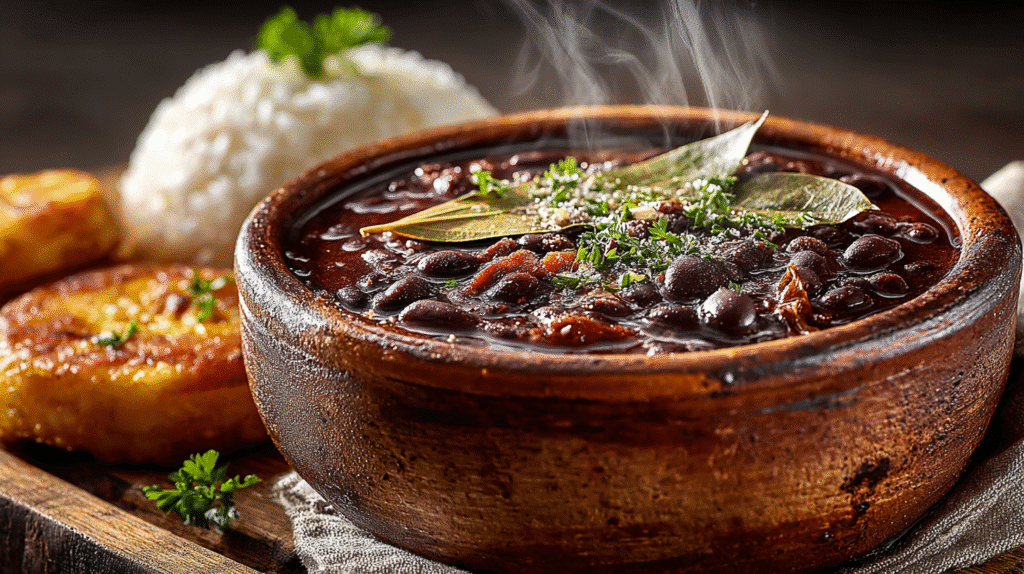
7. Ensalada de Aguacate (Cuban Avocado Salad)
This bright and simple salad brings balance to the richer recipes above. Lightly dressed with lime and olive oil, it refreshes any plate.
Ingredients:
- 2 ripe avocados, sliced
- 1/4 small red onion, thinly sliced
- 2 tablespoons olive oil
- Juice of 1 lime
- Salt and black pepper
Instructions:
- Combine avocado and onion in a bowl.
- Whisk lime juice, oil, and seasoning.
- Drizzle over avocado slices.
- Serve immediately.
This salad makes a wonderful addition to any dessert-friendly summer meal with tropical flair.
PART 4: Smart Storage, Meal Prep & Reheat Tips for Cuban Vegetable Recipes
These Cuban vegetable recipes aren’t just delicious the first time—they also hold up beautifully when prepped in advance or stored for later meals. Here’s how to keep every dish tasting like it was just made, whether you’re enjoying leftovers tomorrow or planning a future feast.
Storing Cuban Dishes the Right Way
Vegetables like plantains and calabaza don’t always store well unless treated properly. Meanwhile, black beans and rice-based dishes are perfect for longer refrigeration or freezing.
Follow these basic storage tips to preserve freshness and texture:
- Cuban Black Beans can be kept in airtight containers in the refrigerator for up to three days. Freeze for up to 3 months. Defrost overnight in the fridge.
- Yuca con Mojo: Best enjoyed fresh but can be refrigerated for 2 days. Reheat gently with extra mojo.
- Roasted Peppers & Onions: Hold well in the fridge for 3–4 days. Excellent in wraps or grain bowls.
- Plátanos Maduros & Tostones: These don’t freeze well but stay crisp in the fridge for 1–2 days. Reheat in a hot pan or oven.
- Calabaza Stew: Freezes like a dream. Portion out and freeze up to 2 months.
- Avocado Salad: This is best made fresh. If needed, toss in lime juice and store for just 1 day max.
Want more batch-cooking ideas? Many of these tips also apply to our Cuban-style dinner recipes that freeze well for busy weeks.
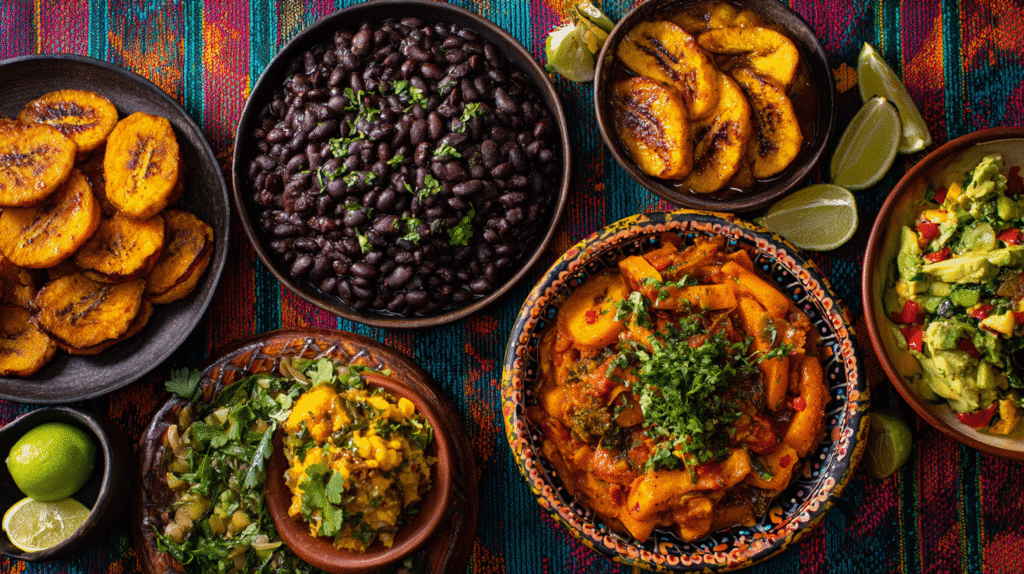
Reheating Cuban Dishes for Peak Flavor
Microwaving might be fast—but it’s not always the best method for reheating traditional Cuban food. Use stovetop and oven techniques to bring back texture and flavor.
- Beans: Reheat in a saucepan with a splash of water to revive their creamy texture.
- Yuca: Steam or pan-fry instead of microwaving, which can make them dry.
- Tostones: Re-crisp in a hot skillet or oven at 375°F for 8 minutes.
- Calabaza a la Cubana: Warm gently in a pot with a spoonful of sofrito or water.
- Avocado Salad: Never reheat—just make fresh!
Meal prep tip: You can prep your sofrito in bulk, freeze it in cubes, and have authentic Cuban flavor on demand.
For readers who plan big batch meals, pair these ideas with lunch recipes that are designed for make-ahead convenience.
Conclusion: Let the Island Flavor Live in Your Kitchen
These Cuban vegetable recipes prove that you don’t need meat or complicated techniques to create a meal with bold personality and cultural depth. Each of these dishes reflects Cuba’s culinary traditions—flavorful, resourceful, and deeply comforting.
Whether you’re prepping tostones for a weekend lunch, stewing calabaza for a cozy dinner, or exploring authentic Cuban cuisine for the first time, these recipes bring tradition and taste together in every bite.
Table of contents
Table of Contents
What vegetables are used in Cuban food?
Traditional Cuban dishes feature starchy roots and tropical vegetables like yuca (cassava), plantains (both green and ripe), calabaza squash, bell peppers, onions, and garlic. These ingredients are foundational in both main dishes and sides.
What is a typical Cuban dish?
Classic Cuban dishes feature black beans and rice, ropa vieja, yuca con mojo, and sweet plátanos maduros.. These dishes blend bold spices like cumin and oregano with simmered vegetables or proteins, making them both hearty and flavorful.
What to serve with Cuban black beans?
Black beans pair well with white rice, sweet fried plantains, roasted vegetables, or avocado salad. Tostones and yuca are also traditional side options that complete the meal.
What is a Cuban potato-like vegetable?
The Cuban equivalent to potatoes is yuca, also known as cassava. It’s a dense, fibrous root that boils up soft and starchy. Served with mojo sauce, it’s a staple in many Cuban homes.
Are Cuban vegetable recipes spicy?
Not traditionally. Cuban food is rich in flavor from spices and aromatics, but it isn’t usually spicy. Want more heat? Add jalapeños or hot sauce to your liking.
Can I make Cuban recipes vegan?
Absolutely. Most of these dishes are naturally vegan or require minimal tweaks. For example, all seven of the recipes above fit perfectly into a vegan Cuban food plan.
What’s the difference between green and ripe plantains?
Green plantains are firm and starchy—perfect for tostones. Ripe plantains are soft and sweet, ideal for frying into plátanos maduros.

